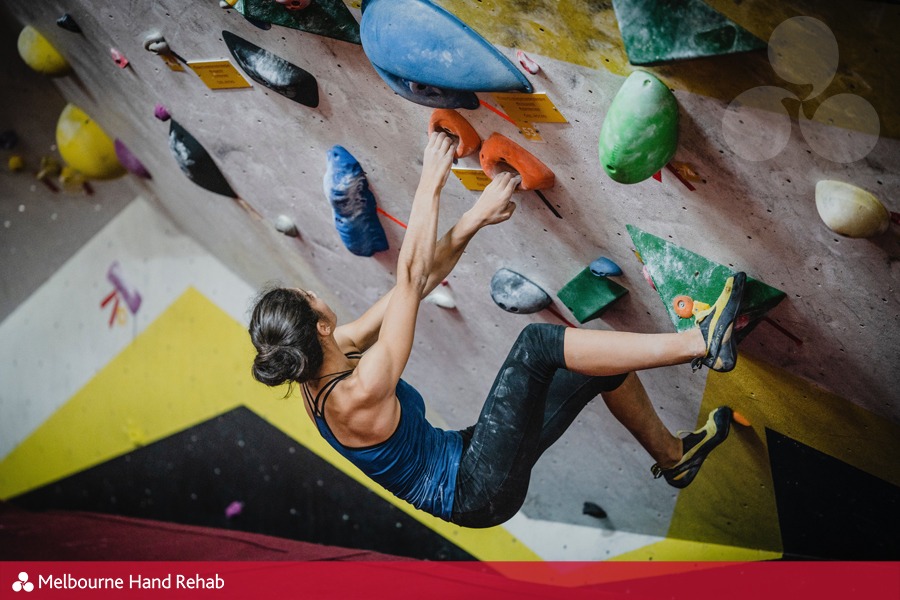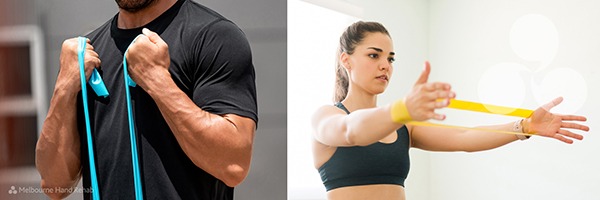
28 Oct Scaling new heights: Injury prevention and hand health when bouldering
Bouldering, the art of climbing short but challenging routes without ropes, has evolved from a niche activity into a mainstream sport embraced by enthusiasts worldwide.
Beyond its reputation as a thrilling physical and mental challenge, bouldering offers significant benefits for strength building and flexibility.
The relationship between the hands and the climbing wall is central to bouldering. Climbers rely heavily on their hands to navigate holds of varying sizes and shapes, requiring a combination of grip strength, flexibility, and precision. As climbers progress through routes, they engage muscles throughout the upper limbs, lower limbs, and core to help keep them stable and in control.
While bouldering offers numerous benefits, it’s not without risks. Hand injuries, such as ligament and tendon injuries, are common among climbers, particularly those who overexert themselves or use improper technique. However, with proper preparation and technique, many of these injuries can be prevented.

Bouldering, the art of climbing short but challenging routes without ropes
Some key tips for injury prevention
1. Warm-Up and Stretching:
Before starting a climbing session, it’s essential to warm up the muscles and joints in the hands, wrists, and forearms. Dynamic stretches and exercises, such as wrist circles and finger extensions, help increase blood flow and flexibility, reducing the risk of strains and sprains. Starting your session on easier climbs can also help you warm up on the wall.
2. Proper Technique:
Technique plays a crucial role in injury prevention. Climbers should focus on using efficient movement patterns and distributing their weight evenly to minimise stress on the hands and wrists. Avoid over-gripping holds and moving dynamically to small holds, and use open-handed grips when possible can help reduce the risk of overuse injuries.
3. Gradual Progression:
Climbers should gradually increase the difficulty and intensity of their climbs to allow their bodies to adapt and strengthen over time. Rushing into challenging routes without proper preparation can lead to overexertion and injury.
Despite precautions, injuries may still occur while bouldering. Prompt and appropriate management is essential to prevent further damage and facilitate recovery.

Warming up your muscles before starting a climbing session is an important part of injury prevention.
Some general guidelines for managing common hand injuries in climbers
Rest:
In the event of a minor injury, rest the affected hand, and use gentle range of motion exercises if they are comfortable. Avoid climbing or engaging in activities that aggravate the injury.
Assessment:
A hand therapist can assess your injury and let you know more about you injury, including the overall plan and healing time frame. They can also discuss how soon you can return to climbing safely.
Rehabilitation Exercises:
Once the acute phase of the injury has passed, rehabilitation exercises can help restore strength, flexibility, and range of motion in the hand and wrist. These may include gentle stretching, resistance exercises, and proprioceptive training to improve coordination and stability.
An exercise splint for rock climbers with PIPJ
synovitis (swollen knuckles).
Bouldering offers a unique platform for individuals to challenge themselves physically and mentally. By incorporating proper warm-up techniques, focusing on technique and gradual progression, and implementing effective injury management strategies, climbers can enjoy bouldering while minimising the risk of hand injuries.
Whether scaling indoor climbing walls or exploring outdoor boulders, climbers can embark on their journey with confidence, knowing they have the knowledge and tools to safeguard their hand health for years to come.
If you are experiencing finger, hand, wrist or shoulder pain, don’t hesitate to get in touch. We’d love to help you.
BOOK AN APPOINTMENT
For more information, call us directly on 03 9458 5166
You might also be interested in:
Image credits: @ynsplt and Andrew Peluso on Unsplash



